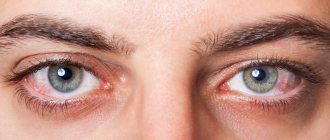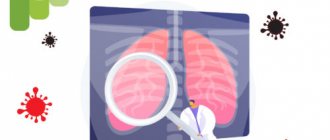Fibrosing alveolitis is a series of progressive lung diseases that are characterized by sclerosis of the interalveolar septa and inflammatory infiltration; in which diffuse pulmonary fibrosis is formed and fibrous restructuring of the lung structures occurs.
Most of the diseases combined under this term are also called interstitial pneumonia. And ordinary interstitial pneumonia is called idiopathic pulmonary fibrosis.
- Epidemiology
- Types of fibrosing alveolitis
- Idiopathic fibrosing alveolitis
- Exogenous allergic alveolitis
- Toxic fibrosing alveolitis
General information about pathologies
Alveolitis can occur independently or be a complication of another disease. Independent forms include alveolitis:
- exogenous allergic;
- idiopathic fibrosing;
- toxic fibrosing. Source: N.S. Lev Interstitial lung diseases in children // Russian Bulletin of Perinatology and Pediatrics, 2008, No. 5, pp. 28-35
The basis of the pathological process is the body’s response to stimuli (from tissues or the immune system). They can be substances that come from outside, as well as those produced by the body during certain diseases. If the alveolar tissue is constantly exposed to irritants, then the pathology becomes chronic, the affected tissue is replaced by connective tissue (fibrous), and the alveoli, which are extensively susceptible to fibrosis, are excluded from the breathing process.
Treatment prognosis varies depending on the form of the disease and its neglect. If cardiopulmonary failure develops, life expectancy after treatment is quite short. This explains the extreme need to urgently consult a doctor at the slightest suspicion of any lung pathology. Source: https://www.ncbi.nlm.nih.gov/pubmed/30519307 ChILD - Children's interstitial lung disease // Breathe (Sheff). 2018 Dec;14(4):349-352. doi: 10.1183/20734735.ELF144
Epidemiology
Existing data on the prevalence of these diseases are contradictory. But in most countries there is a constant increase in cases of fibrosing alveolitis. Epidemiological patterns have been clearly identified for allergic alveolitis. Their prevalence depends on a number of factors:
- environmental
- geographical
- household
- professional
The highest numbers of cases are reported among poultry farmers, workers who handle certain types of wood, and those whose work involves flour production. Toxic fibrosing alveolitis is associated with the use of certain medications.
Causes
The prerequisites for the development of alveolitis vary, depending on the form of the disease. In general, heredity and disruption of collagen metabolism, as well as the presence of allergies, play an important role.
General symptoms:
- hard breath;
- dry cough;
- shortness of breath (first during exercise, and then at rest);
- rarely – pulmonary wheezing;
- cyanosis of the superficial skin and mucous membranes;
- accompanying signs: weight loss, general weakness, vulnerability to infections;
- if the disease is severe, then the following are likely: headaches, fever, muscle pain, airway obstruction, persistent cough, which can be wet with a small amount of sputum. Source: D.V. Kazymova, E.N. Akhmadeeva, D.E. Baikov Intertitial lung diseases in children: clinical and radiological characteristics // Practical Medicine, 2013, No. 5(74), pp. 79-83
General principles of treatment
Therapy for alveolitis is aimed at eliminating the causes of their occurrence. The child may be prescribed glucocorticosteroids, anti-inflammatory drugs, immunostimulants, and antihistamines. Sometimes physiotherapy is added, as well as spa treatment.
The early stages of alveolitis are easy to treat. Once the fibrotic process has begun, it cannot be stopped; the tissue will not recover. The disease becomes chronic, and the predicted life expectancy is 2-6 years.
DIAGNOSTICS
It is important for specialists to conduct a correct and accurate differential diagnosis of idiopathic dental alveolitis in order to prescribe timely therapy and antibiotics. Sometimes a dentist in a clinic will be able to identify the chronicity of the process (more than a month) during preventive advisory examinations of the oral cavity. In the area of the missing unit, there is an empty cavity without granulation with visible bone at the bottom. For accurate differential To diagnose the type of alveolitis, an x-ray of the affected area is prescribed.
Types of disease, causes, symptoms, treatment
EAA (exogenous allergic alveolitis)
| Origin | Entry into the lungs of antigens of fungal, animal, and plant origin through inhalation of organic dust. These can be bird feathers, flax particles, livestock excrement and many others. Factors in the development of the disease in children are constant contact with poultry or ornamental poultry, organic feed, etc. |
| Development mechanism | Allergens provoke the formation of IgG (precipitins) and immune complexes in the lungs. Tissue damage occurs due to activation of complement and/or a destructive enzyme. |
| Passing changes | In the walls of the alveoli during the acute phase, inflammatory infiltrates and granulomas are diagnosed in their septa. If the disease is advanced, the composition of the respiratory part of the lungs is disrupted, and irreversible local enlargements of the bronchi and a “honeycomb” lung are formed. |
| Clinic | The illness begins acutely, a bit like the flu. Against the background of chills, fever, pain in the extremities, the following appear: moist rales, shortness of breath, cough. X-rays may show reduced transparency of the lungs, sometimes multiple infiltrates. |
| Forecast | If contact with the allergen is stopped, the child recovers. If contact continues, a chronic phase is formed: a dry or “sputum” cough, shortness of breath, wheezing, the chest is deformed, the fingers become like drumsticks, the patient quickly gets tired, loses weight, “pulmonary heart” occurs, the level of oxygen in the blood is constantly reduced. The process can be stabilized, but not completely cured. |
| Treatment methods | Elimination of the allergen, and if it is present, the chronic form and exacerbations of the disease - corticosteroid drugs. Their type, dosage and duration of use, combination with other drugs are determined by the doctor. Source: N.S. Lev, N.N. Rozinova, Yu.L. Mizernitsky, S.E. Dyakova, M.V. Kostyuchenko, A.E. .Bogorad, L.V.Sokolova, I.E.Zorina, N.A.Geppe, A.B.Malakhov, E.I.Shmelev, O.I.Simonova, Yu.V.Gorinova Hypersensitivity pneumonitis (exogenous allergic alveolitis ) in children (diagnosis and treatment) // Pediatrics. Supplement to the journal Consilium Medicum, 2021, No. 4, pp. 10-17 |
ELISA (idiopathic fibrosing alveolitis, also called Hamman-Rich disease)
| Origin | At the moment, no reliable reasons have been identified. |
| Development mechanism | The process of production and destruction of collagen is disrupted, which leads to an incorrect ratio of its types and incorrect fiber structure. Sometimes immune complexes are formed in the alveolar capillaries, antinuclear antibodies and rheumatoid factor are present. |
| Passing changes | The lungs decrease in size, cysts form in them, the tissue becomes denser, and the lymph nodes enlarge. The saturation of the lungs with air is low. Fibrous tissue grows, the alveolar septa thicken due to inflammation, and a “honeycomb” lung develops. |
| Clinic | In children, the disease manifests itself as a dry or moderately sputum cough and shortness of breath. This form has an early onset, the patient gradually loses weight, gets tired quickly, the fingers resemble drumsticks, the chest is deformed, wheezing appears (can disappear and appear again). On radiography, as the process develops: the pulmonary pattern is changed, blurred, the tissue has reduced transparency, the volume of the lungs is reduced, there are areas of swelling on the periphery, the bronchi are dilated, there are cords, the mediastinum is displaced, etc. (manifestations can be individual or complex). Blood components are usually normal, in patients the ventilation of the lungs is impaired (restrictive type), the body experiences oxygen starvation. A “pulmonary heart” may form. |
| Forecast | If the disease is detected at an early age, then depending on its degree and severity, patients can live from several months to many decades. |
| Treatment methods | Combined corticosteroid therapy is used, vitamin complexes, potassium, breathing exercises, exercise therapy, and constant monitoring by a pulmonologist are prescribed. |
TFA (toxic fibrosing alveolitis)
| Origin | Exposure of lung tissue to toxins and harsh chemicals by inhalation or through the blood. These could be medications, industrial toxins, volatile fertilizers, etc. Children rarely suffer from this form of the disease and only in areas with a high distribution and concentration of toxins in the air. |
| Development mechanism | Toxins cause pathological changes in lung tissue or act indirectly (through immune changes). |
| Passing changes | Swelling of the alveolar septa, death of type 1 alveolar cells, changes in the capillaries, development of fibrosis. |
| Clinic | Dry cough, shortness of breath, wheezing, hypoxia. X-rays show a clearer pulmonary pattern if fibrosis is present. |
| Forecast | The prognosis is favorable in the absence of fibrosis. Once this process begins, it can no longer be stopped. |
| Treatment methods | Eliminate exposure to the toxin and use corticosteroid therapy to speed up recovery. |
Possible consequences
If you no longer interact with the allergen, the prognosis is favorable. If you continue to contact him, complications develop. Over time, all patients suffering from allergic alveolitis develop chronic bronchitis. A quarter of patients experience pathological expansion of the alveoli (pulmonary emphysema). Intrapulmonary pressure often increases, causing the right chambers of the heart to enlarge and right ventricular failure to develop. If left untreated, pulmonary fibrosis occurs - the proliferation of connective tissue, which reduces the elasticity of the organ and also prevents the passage of oxygen and carbon dioxide through the alveolar walls.
Advantages of contacting SM-Clinic
Our clinic employs some of the best pulmonologists in St. Petersburg. Instrumental and laboratory tests are carried out in a timely manner. Qualified specialists prescribe the most effective treatment on an individual basis.
We do everything to restore the joy of a healthy life to your children and prevent future complications.
Sources:
- N.S. A lion. Interstitial lung diseases in children // Russian Bulletin of Perinatology and Pediatrics, 2008, No. 5, pp. 28-35.
- https://www.ncbi.nlm.nih.gov/pubmed/30519307 ChILD - Children's interstitial lung disease // Breathe (Sheff). 2018 Dec;14(4):349-352. doi: 10.1183/20734735.ELF144.
- D.V. Kazymova, E.N. Akhmadeeva, D.E. Baykov. Intertitial lung diseases in children: clinical and radiological characteristics // Practical Medicine, 2013, No. 5(74), pp. 79-83.
- N.S. Lev, N.N. Rozinova, Yu.L. Mizernitsky, S.E. Dyakova, M.V. Kostyuchenko, A.E. Bogorad, L.V. Sokolova, I.E. Zorina, N. A. Geppe, A. B. Malakhov, E. I. Shmelev, O. I. Simonova, Yu. V. Gorinova. Hypersensitivity pneumonitis (exogenous allergic alveolitis) in children (diagnosis and treatment) // Pediatrics. Supplement to the journal Consilium Medicum, 2021, No. 4, pp. 10-17.
The information in this article is provided for reference purposes and does not replace advice from a qualified professional. Don't self-medicate! At the first signs of illness, you should consult a doctor.
Prevention of alveolitis
Prevention of alveolitis involves following the rules for working with toxic substances and eliminating irritants that cause an allergic reaction. It is necessary to undergo regular examinations by a pulmonologist and rheumatologist. Prevention of alveolitis with the help of medications is not provided.
Author of the article:
Alekseeva Maria Yurievna |
Therapist Education: From 2010 to 2021 practicing physician at the therapeutic hospital of the central medical unit No. 21, the city of Elektrostal. Since 2021 he has been working at diagnostic center No. 3. Our authors
Prices
| Name of service (price list incomplete) | Price |
| Appointment (examination, consultation) with a pulmonologist, primary, therapeutic and diagnostic, outpatient | 1750 rub. |
| Consultation with a candidate of medical sciences | 2500 rub. |
| Professor consultation | 4300 rub. |
| Consultation (interpretation) with analyzes from third parties | 2250 rub. |
| Prescription of treatment regimen (for up to 1 month) | 1800 rub. |
| Study of external respiratory function (RPF) with drug tests | 1800 rub. |
| X-ray of the chest organs (survey) | 1900 rub. |
| X-ray of the chest organs in 2 projections | 2900 rub. |







